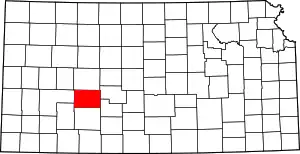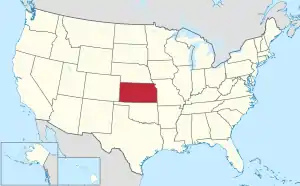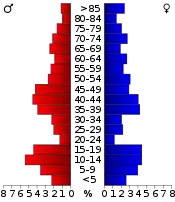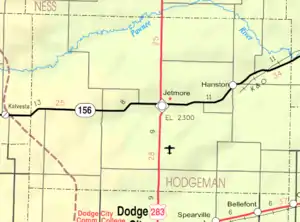Hodgeman County, Kansas
Hodgeman County is a county located in the U.S. state of Kansas. Its county seat and most populous city is Jetmore.[3] As of the 2020 census, the county population was 1,723.[1] It was named for Amos Hodgman, a member of the 7th Regiment Kansas Volunteer Cavalry.
Hodgeman County | |
|---|---|
_from_W_2.JPG.webp) Hodgeman County Courthouse in Jetmore (2016) | |
 Location within the U.S. state of Kansas | |
 Kansas's location within the U.S. | |
| Coordinates: 38°02′38″N 100°10′17″W | |
| Country | |
| State | |
| Founded | February 26, 1867 |
| Named for | Amos Hodgman |
| Seat | Jetmore |
| Largest city | Jetmore |
| Area | |
| • Total | 860 sq mi (2,200 km2) |
| • Land | 860 sq mi (2,200 km2) |
| • Water | 0.3 sq mi (0.8 km2) 0.04% |
| Population | |
| • Total | 1,723 |
| • Estimate (2021)[2] | 1,710 |
| • Density | 2.0/sq mi (0.8/km2) |
| Time zone | UTC−6 (Central) |
| • Summer (DST) | UTC−5 (CDT) |
| Congressional district | 1st |
| Website | hodgemancountyks.com |
History
For many millennia, the Great Plains of North America was inhabited by nomadic Native Americans.
In 1854, the Kansas Territory was organized, then in 1861 Kansas became the 34th U.S. state.
In 1867, Hodgeman County was established, and named for Amos Hodgman, member of the 7th Regiment Kansas Volunteer Cavalry. The letter E was later added to the namesake's name.[4]
Geography
According to the United States Census Bureau, the county has a total area of 860 square miles (2,200 km2), of which 860 square miles (2,200 km2) is land and 0.3 square miles (0.78 km2) (0.04%) is water.[5]
Adjacent counties
- Ness County (north)
- Pawnee County (east)
- Edwards County (southeast)
- Ford County (south)
- Gray County (southwest)
- Finney County (west)
Demographics

| Census | Pop. | Note | %± |
|---|---|---|---|
| 1880 | 1,704 | — | |
| 1890 | 2,895 | 69.9% | |
| 1900 | 2,032 | −29.8% | |
| 1910 | 2,930 | 44.2% | |
| 1920 | 3,734 | 27.4% | |
| 1930 | 4,157 | 11.3% | |
| 1940 | 3,535 | −15.0% | |
| 1950 | 3,310 | −6.4% | |
| 1960 | 3,115 | −5.9% | |
| 1970 | 2,662 | −14.5% | |
| 1980 | 2,269 | −14.8% | |
| 1990 | 2,177 | −4.1% | |
| 2000 | 2,085 | −4.2% | |
| 2010 | 1,916 | −8.1% | |
| 2020 | 1,723 | −10.1% | |
| 2021 (est.) | 1,710 | [2] | −0.8% |
| U.S. Decennial Census[6] 1790-1960[7] 1900-1990[8] 1990-2000[9] 2010-2020[1] | |||
As of the census of 2000, there were 2,085 people, 796 households, and 581 families residing in the county. The population density was 2 people per square mile (0.77 people/km2). There were 945 housing units at an average density of 1 per square mile (0.39/km2). The racial makeup of the county was 97.31% White, 0.91% Black or African American, 0.24% Native American, 0.48% from other races, and 1.06% from two or more races. Hispanic or Latino of any race were 2.69% of the population.
There were 796 households, out of which 34.70% had children under the age of 18 living with them, 65.10% were married couples living together, 4.40% had a female householder with no husband present, and 27.00% were non-families. 24.70% of all households were made up of individuals, and 14.20% had someone living alone who was 65 years of age or older. The average household size was 2.58 and the average family size was 3.09.
In the county, the population was spread out, with 29.00% under the age of 18, 4.70% from 18 to 24, 25.20% from 25 to 44, 22.10% from 45 to 64, and 19.00% who were 65 years of age or older. The median age was 40 years. For every 100 females there were 97.30 males. For every 100 females age 18 and over, there were 96.90 males.
The median income for a household in the county was $35,994, and the median income for a family was $39,358. Males had a median income of $27,568 versus $21,534 for females. The per capita income for the county was $15,599. About 10.70% of families and 11.50% of the population were below the poverty line, including 11.90% of those under age 18 and 7.70% of those age 65 or over.
Government
Presidential elections
Hodgeman County is a Republican stronghold. Only six Republican presidential candidates have failed to win the county from 1888 to the present, and no Democrat has to managed to win even a quarter of the county's votes since Michael Dukakis in 1988. The last Democrat to carry the county was Jimmy Carter in 1976.
| Year | Republican | Democratic | Third party | |||
|---|---|---|---|---|---|---|
| No. | % | No. | % | No. | % | |
| 2020 | 875 | 83.73% | 154 | 14.74% | 16 | 1.53% |
| 2016 | 855 | 84.07% | 124 | 12.19% | 38 | 3.74% |
| 2012 | 868 | 81.89% | 179 | 16.89% | 13 | 1.23% |
| 2008 | 865 | 78.92% | 211 | 19.25% | 20 | 1.82% |
| 2004 | 953 | 80.56% | 223 | 18.85% | 7 | 0.59% |
| 2000 | 835 | 76.75% | 217 | 19.94% | 36 | 3.31% |
| 1996 | 808 | 69.42% | 251 | 21.56% | 105 | 9.02% |
| 1992 | 625 | 50.85% | 258 | 20.99% | 346 | 28.15% |
| 1988 | 732 | 60.40% | 439 | 36.22% | 41 | 3.38% |
| 1984 | 939 | 74.17% | 306 | 24.17% | 21 | 1.66% |
| 1980 | 831 | 66.16% | 339 | 26.99% | 86 | 6.85% |
| 1976 | 576 | 43.80% | 697 | 53.00% | 42 | 3.19% |
| 1972 | 853 | 68.40% | 331 | 26.54% | 63 | 5.05% |
| 1968 | 756 | 59.20% | 387 | 30.31% | 134 | 10.49% |
| 1964 | 607 | 42.33% | 821 | 57.25% | 6 | 0.42% |
| 1960 | 926 | 61.45% | 570 | 37.82% | 11 | 0.73% |
| 1956 | 1,113 | 71.62% | 435 | 27.99% | 6 | 0.39% |
| 1952 | 1,330 | 76.44% | 392 | 22.53% | 18 | 1.03% |
| 1948 | 945 | 60.77% | 590 | 37.94% | 20 | 1.29% |
| 1944 | 982 | 66.31% | 490 | 33.09% | 9 | 0.61% |
| 1940 | 1,092 | 60.87% | 690 | 38.46% | 12 | 0.67% |
| 1936 | 781 | 40.13% | 1,162 | 59.71% | 3 | 0.15% |
| 1932 | 847 | 45.56% | 988 | 53.15% | 24 | 1.29% |
| 1928 | 1,122 | 67.55% | 528 | 31.79% | 11 | 0.66% |
| 1924 | 899 | 60.66% | 367 | 24.76% | 216 | 14.57% |
| 1920 | 945 | 73.31% | 306 | 23.74% | 38 | 2.95% |
| 1916 | 564 | 37.45% | 761 | 50.53% | 181 | 12.02% |
| 1912 | 136 | 17.17% | 302 | 38.13% | 354 | 44.70% |
| 1908 | 411 | 57.08% | 290 | 40.28% | 19 | 2.64% |
| 1904 | 449 | 67.52% | 192 | 28.87% | 24 | 3.61% |
| 1900 | 323 | 56.27% | 245 | 42.68% | 6 | 1.05% |
| 1896 | 262 | 53.69% | 224 | 45.90% | 2 | 0.41% |
| 1892 | 363 | 61.21% | 0 | 0.00% | 230 | 38.79% |
| 1888 | 563 | 63.98% | 220 | 25.00% | 97 | 11.02% |
Laws
Following amendment to the Kansas Constitution in 1986, the county remained an alcohol-free, or "dry", county until 2004, when voters approved the sale of alcoholic beverages by the individual drink with a 30% food sales requirement.[11]
Education
Unified school districts
- Hodgeman County USD 227
Communities

Townships
Hodgeman County is divided into nine townships. None of the cities within the county are considered governmentally independent, and all figures for the townships include those of the cities. In the following table, the population center is the largest city (or cities) included in that township's population total, if it is of a significant size.
| Township | FIPS | Population center |
Population | Population density /km2 (/sq mi) |
Land area km2 (sq mi) | Water area km2 (sq mi) | Water % | Geographic coordinates |
|---|---|---|---|---|---|---|---|---|
| Benton | 06225 | 48 | 1 (1) | 93 (36) | 0 (0) | 0.13% | 38°2′39″N 100°10′18″W | |
| Center | 11725 | 1,121 | 3 (8) | 374 (144) | 0 (0) | 0.05% | 38°5′7″N 99°53′46″W | |
| Hallet | 29525 | 62 | 0 (1) | 182 (70) | 0 (0) | 0% | 38°5′40″N 100°4′10″W | |
| Marena | 44575 | 432 | 1 (3) | 373 (144) | 0 (0) | 0.05% | 38°9′52″N 99°41′19″W | |
| North Roscoe | 51350 | 51 | 0 (0) | 276 (106) | 0 (0) | 0.05% | 38°10′29″N 100°7′14″W | |
| Sawlog | 63225 | 93 | 0 (1) | 187 (72) | 0 (0) | 0.02% | 37°58′18″N 99°54′32″W | |
| South Roscoe | 66900 | 76 | 0 (1) | 185 (71) | 0 (0) | 0.04% | 37°56′59″N 100°6′31″W | |
| Sterling | 68175 | 144 | 0 (1) | 374 (144) | 0 (0) | 0.02% | 37°59′46″N 99°40′24″W | |
| Valley | 72825 | 58 | 0 (1) | 185 (71) | 0 (0) | 0% | 38°12′41″N 99°51′47″W | |
| Sources: "Census 2000 U.S. Gazetteer Files". U.S. Census Bureau, Geography Division. Archived from the original on August 2, 2002. | ||||||||
In popular culture
At the beginning of the 1992 film Unforgiven, the protagonist William Munny, played by Clint Eastwood, is living in Hodgeman County and working as a pig farmer, while attempting to hide evidence of his violent past from all those around him.
See also
- Community information for Kansas
References
- "QuickFacts; Hodgeman County, Kansas; Population, Census, 2020 & 2010". United States Census Bureau. Archived from the original on August 17, 2021. Retrieved August 16, 2021.
- "Annual Estimates of the Resident Population for Counties: April 1, 2020 to July 1, 2021". Retrieved October 23, 2022.
- "Find a County". National Association of Counties. Archived from the original on May 31, 2011. Retrieved June 7, 2011.
- Blackmar, Frank Wilson (1912). Kansas: A Cyclopedia of State History, Embracing Events, Institutions, Industries, Counties, Cities, Towns, Prominent Persons, Etc. Standard Publishing Company. pp. 859–860.
- "US Gazetteer files: 2010, 2000, and 1990". United States Census Bureau. February 12, 2011. Retrieved April 23, 2011.
- "U.S. Decennial Census". United States Census Bureau. Retrieved July 26, 2014.
- "Historical Census Browser". University of Virginia Library. Retrieved July 26, 2014.
- "Population of Counties by Decennial Census: 1900 to 1990". United States Census Bureau. Retrieved July 26, 2014.
- "Census 2000 PHC-T-4. Ranking Tables for Counties: 1990 and 2000" (PDF). United States Census Bureau. Archived (PDF) from the original on March 27, 2010. Retrieved July 26, 2014.
- "Dave Leip's Atlas of U.S. Presidential Elections".
- "Map of Wet and Dry Counties". Alcoholic Beverage Control, Kansas Department of Revenue. November 2006. Archived from the original on October 8, 2007. Retrieved December 26, 2007.
- Notes
Further reading
- Handbook of Hodgeman County, Kansas; C.S. Burch Publishing Co; 34 pages; 1887.
- Standard Atlas of Hodgeman County, Kansas; Geo. A. Ogle & Co; 56 pages; 1907.
External links
- County
- Maps